BPC-157, TB-500, KPV, GHK-Cu 80mg (Klow Blend) (复制9)
BPC-157 10mg, TB-500 (Thymosin Beta-4) 10mg, KPV 10mg, GHK-Cu 50mg
(80mg Total Klow Blend)
The BPC157, TB500 (43 amino acid Thymosin Beta-4), KPV, and GHK-Cu quad blend combines four well-studied peptides that work through different but complementary pathways. BPC157 has been researched for supporting faster tissue healing, new blood vessel growth, and protection of the stomach and gut lining. TB500, the full 43aa Thymosin Beta-4 peptide, helps regulate actin, a key protein for cell movement and repair, and plays an important role in wound healing and tissue regeneration. KPV, a short fragment of alpha-MSH, is known for its anti-inflammatory and antimicrobial effects, mainly by reducing overactive immune signaling. GHK-Cu is a natural copper-binding peptide that stimulates collagen production, skin and hair regeneration, and cellular repair. Together, these four peptides may act synergistically—BPC157 and Thymosin Beta-4 strengthen repair and blood flow, KPV calms inflammation, and GHK-Cu drives tissue remodeling and renewal—making this blend a broad research platform for studying healing and regeneration
$395.00
- Peptides will arrive in a lyophilized (powder) form for maximum stability
产品
-
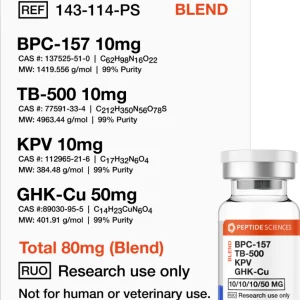 BPC-157, TB-500, KPV, GHK-Cu 80mg (Klow Blend) (复制12)
$395.00
BPC-157, TB-500, KPV, GHK-Cu 80mg (Klow Blend) (复制12)
$395.00
-
 BPC-157, TB-500, KPV, GHK-Cu 80mg (Klow Blend) (复制11)
$395.00
BPC-157, TB-500, KPV, GHK-Cu 80mg (Klow Blend) (复制11)
$395.00
-
 BPC-157, TB-500, KPV, GHK-Cu 80mg (Klow Blend) (复制9)
$395.00
BPC-157, TB-500, KPV, GHK-Cu 80mg (Klow Blend) (复制9)
$395.00
-
 BPC-157, TB-500, KPV, GHK-Cu 80mg (Klow Blend) (复制10)
$395.00
BPC-157, TB-500, KPV, GHK-Cu 80mg (Klow Blend) (复制10)
$395.00
-
 BPC-157, TB-500, KPV, GHK-Cu 80mg (Klow Blend) (复制8)
$395.00
BPC-157, TB-500, KPV, GHK-Cu 80mg (Klow Blend) (复制8)
$395.00
-
 BPC-157, TB-500, KPV, GHK-Cu 80mg (Klow Blend) (复制7)
$395.00
BPC-157, TB-500, KPV, GHK-Cu 80mg (Klow Blend) (复制7)
$395.00
-
 BPC-157, TB-500, KPV, GHK-Cu 80mg (Klow Blend) (复制6)
$395.00
BPC-157, TB-500, KPV, GHK-Cu 80mg (Klow Blend) (复制6)
$395.00
-
 BPC-157, TB-500, KPV, GHK-Cu 80mg (Klow Blend) (复制5)
$395.00
BPC-157, TB-500, KPV, GHK-Cu 80mg (Klow Blend) (复制5)
$395.00
-
 BPC-157, TB-500, KPV, GHK-Cu 80mg (Klow Blend) (复制4)
$395.00
BPC-157, TB-500, KPV, GHK-Cu 80mg (Klow Blend) (复制4)
$395.00
-
 BPC-157, TB-500, KPV, GHK-Cu 80mg (Klow Blend) (复制3)
$395.00
BPC-157, TB-500, KPV, GHK-Cu 80mg (Klow Blend) (复制3)
$395.00
-
 BPC-157, TB-500, KPV, GHK-Cu 80mg (Klow Blend) (复制2)
$395.00
BPC-157, TB-500, KPV, GHK-Cu 80mg (Klow Blend) (复制2)
$395.00
-
 BPC-157, TB-500, KPV, GHK-Cu 80mg (Klow Blend) (复制)
$395.00
BPC-157, TB-500, KPV, GHK-Cu 80mg (Klow Blend) (复制)
$395.00
-
 BPC-157, TB-500, KPV, GHK-Cu 80mg (Klow Blend)
$395.00
BPC-157, TB-500, KPV, GHK-Cu 80mg (Klow Blend)
$395.00
BPC-157 + TB-500 (Thymosin Beta 4) + KPV + GHK-Cu Blend
BPC-157, TB500, GHK-Cu, and KPV are peptides known for their healing and anti-inflammatory properties. Each of these peptides has been heavily researched in the areas of wound healing, tissue regeneration, muscle and tendon growth, and the control of DNA expression patterns. Each of them has been shown to have positive effects on aging as well, helping to slow the aging process at various levels and improve both lifespan and healthspan. Though each of these peptides is known for its ability to regenerate and heal tissue, they work in different ways and thus can likely be used in combination to create synergistic benefits.
A blend of BPC-157 + TB500 (Thymosin Beta 4) + GHK-Cu + KPV has been created to aid in the process of researching the synergistic healing properties of these peptides. This blend makes ordering, storage, dosing, and administration of these peptides easier, allowing researchers to focus on measuring outcomes and designing experiments rather than creating protocols for administering multiple individual peptides.
BPC-157: Biochemistry
BPC-157 is a synthetic peptide consisting of 15 amino acids. It is derived from a naturally occurring compound in the body known as Body Protective Compound (BPC). Originally isolated from human gastric juice, BPC has demonstrated strong anti-inflammatory and wound-healing properties. In animal studies, BPC-157 has shown potential tissue regeneration benefits across various systems, including the gastrointestinal tract, liver, pancreas, ligaments, muscles, tendons, cornea, heart, brain, and nerves.
While the exact mechanism by which BPC-157 exerts its effects remains unclear, several theories have emerged. It is not yet known whether the peptide acts through binding to cell surface receptors or by entering cells and directly influencing genetic activity. In truth, BPC-157 may operate through both mechanisms.
Research has consistently shown that BPC-157 significantly affects nitric oxide (NO) signaling—particularly through its regulation of endothelial nitric oxide synthase (eNOS). This is believed to underlie many of its therapeutic effects because NO promotes the migration of vascular endothelial cells that are important in tissue repair and the growth of new blood vessels. There is recent evidence indicating that BPC-157 promtes the phosphorylation of Src, Cav-1, and eNOS. It also reduces the binding interaction between Cav-1 and eNOS, an essential step in eNOS activation and NO production [1] .
BPC-157 is known for its rapid absorption and systemic distribution when orally administered or injected. Within 10 minutes of injection, the peptide is detectable throughout the body, including the kidneys, liver, stomach wall, thymus, reproductive organs, and spleen. Peak concentrations in tissues are typically reached about one hour after administration and gradually decline over the following 48 hour [2] . The highest levels are usually found in the kidney, liver, thymus, and spleen, with moderate distribution in the lungs, muscles, brain, and skin.
Many of the effects of BPC-157 are thought to occur through the alteration of gene expression patterns. Again, the mechanism by which this occurs has yet to be elucidated, but the peptide has been shown to definitively alter the expression patterns of:
• Egr,
• Nos (especially eNos),
• Srf,
• Vegr,
• Plcγ, and
• Kras.
These genes control the synthesis of a number of factors that affect cells of blood vessels and the immune system. BPC-157 has been shown to alter fundamental properties of cells like migration, adhesion, thrombosis, and inflammatory responses. These alterations result in changes to cell behavior that help to regulate inflammation and improve tissue healing. Additional research shows that expression levels of each gene are increased or decreased based on the timeframe following administration of BPC-157. In other words, the length of time that BPC-157 is in the system is important in determining which genes are activated. This suggests that BPC-157 is working through a complex regulatory mechanism that has fine-grained control over a wide array of genes and their expression.
An Overview of the complex actions of BPC-157 on various cellular signaling molecules. Note the profound effects on NO signaling and VEGF expression as well as several impacts on inflammatory enzymes like COX-1 and COX-2.
Source: MDPI
.
TB-500: Biochemistry
TB500 is a synthetic peptide derived from thymosin beta-4 (TB-4), a naturally occurring protein in the human body known for its anti-inflammatory and tissue-repairing properties. Like TB-4, TB500 binds to actin and plays a role in gene regulation. It has demonstrated benefits across various systems, including cardiovascular health, muscle regeneration, immune modulation, and central nervous system function. TB500 has even been linked to promoting hair growth and mitigating some effects of aging.
TB500 operates through two primary mechanisms:
- Actin Sequestration and Cell Motility Regulation:
Within cells, TB500 binds to and sequesters actin, a key component of the cytoskeleton. This interaction is crucial for regulating cell movement, growth, and division. By enhancing cell motility, TB500 supports faster wound healing, improved immune cell trafficking, reduced inflammation, and increased angiogenesis (blood vessel formation). - Gene Expression Modulation (“Moonlighting” Function): Beyond its structural role, TB500 also influences gene expression independent of actin binding. It modulates the expression of genes involved in nitric oxide (NO) production, angiogenesis, and cellular proliferation—paralleling several downstream effects observed with BPC-157. Through this regulatory function, TB500 affects cytokine secretion and modulates multiple signaling pathways associated with the inflammatory response. Notably, it downregulates pathways such as NF-κB and Toll-like receptor signaling, thereby suppressing pro-inflammatory cytokines like TNF-α and IL-1 receptor-associated kinases.
In addition to controlling inflammation, TB500 activates several tissue repair pathways, including PI3K/Akt/eNOS, Notch, and angiopoietin-1/Tie signaling. One of its most studied actions involves modulation of the TGF-β pathway, which plays a central role in reducing fibrosis (scarring)—making TB500 particularly valuable in the context of chronic injury and tissue regeneration.
As an aside, there is research to show that TB500 influences Wnt signaling. This has been shown to promote the formation of hair follicles and boost hair growth at the level of DNA expression patterns [4] . The diagram below offers any overviews of the complex and wide-ranging influences of TB500.
An overview of the complex signaling pathway of Thymosin Beta-4 and therefore TB500.
Source: PubMed
GHK-Cu: Biochemistry
GHK-Cu is a naturally occurring copper complex composed of a short peptide (GHK) bound to copper(II) ions. Initially isolated from human plasma, it has also been detected in saliva and urine. Animal studies have shown that GHK-Cu plays a significant role in wound healing and modulating inflammatory responses. It is particularly known for its ability to stimulate collagen production and promote the growth of skin fibroblasts, which has led to its widespread use in cosmetic formulations as an anti-aging compound.
GHK-Cu exerts its effects largely by regulating the activity of key enzymes involved in tissue remodeling. It stimulates the production of metalloproteinases, enzymes that break down damaged proteins to facilitate tissue repair. At the same time, it promotes the expression of anti-proteases, which help preserve healthy proteins from degradation. Much like BPC-157, GHK-Cu appears to orchestrate a delicate balance between protein synthesis and breakdown through gene regulation, supporting a highly coordinated wound healing process—especially within the skin and connective tissue.
This is just one of several pathways by which GHK-Cu is thought to work. Note the downstream impacts on inflammatory cytokines and immune cell infiltration that help to reduce inflammation and therefore tissue damage. Note also the increase in production of antioxidant rejuvenators like superoxide dismutase and glutathione.
Source: PubMed
KPV: Biochemistry
KPV is a short, three–amino acid peptide derived from the C-terminal end of alpha-melanocyte- stimulating hormone (α-MSH), making it the smallest peptide in this group. Despite its size, KPV exhibits a wide range of biological activities. It has been studied for its potential roles in modulating ischemia, influencing sexual behavior and appetite, maintaining energy balance, and offering protection against UV radiation. Most notably, KPV is recognized for its potent anti-inflammatory properties, with effects observed in the gastrointestinal tract, lungs, and even the central nervous system. Additionally, it boasts excellent oral bioavailability, a rare feature among therapeutic peptides.
While KPV can bind to melanocortin receptors—particularly showing an affinity for MC1R—its mechanisms of action appear to be largely independent of these pathways. Unlike its parent molecule α- MSH, KPV does not rely on melanocortin receptor binding to exert its therapeutic effects. However, the precise molecular mechanisms behind its role in wound healing and inflammation resolution remain under investigation.
KPV’s anti-inflammatory capabilities were first identified in 1984, when animal studies showed its effectiveness in reducing a wide range of inflammatory conditions, including fever, dermatitis, vasculitis, fibrosis, arthritis, uveitis, gastritis, and inflammation of the brain and lungs. Its broad anti-inflammatory action appears to involve modulation of several key biological pathways:
- Inhibition of nuclear factor-kappaB (NF-κB)
- Downregulation of adhesion molecules and chemokine receptors
- Suppression of pro-inflammatory cytokine production Regulation of T-cell activity and inflammatory cell migration
- Enhancement of antioxidant enzyme expression
- Modulation of apoptosis-related pathways
Although KPV is generally less potent than α-MSH in terms of anti-inflammatory activity, its superior oral bioavailability makes it a highly attractive therapeutic option. Additionally, KPV potency and half-life can be increased via glycoalkylation. Under experiments designed to mimic conditions within the body, unmodified KPV degraded to its three constituent amino acids within 24 hours but α-glycoalkylated KPV was completely stable. This indicates a successful modification of KPV to improve its chemical degradation without impacting its biological activity [5].
A particularly intriguing feature of KPV is its tissue-selectivity: it primarily acts in areas of excessive or pathological inflammation, while leaving healthy tissues and normal immune responses largely unaffected. Animal models suggest that KPV does not interfere with appropriate inflammatory responses, such as those involved in normal wound healing. This targeted action makes KPV both safe and easy to administer, with a very low risk of overdose or systemic side effects.[6].
An overview of the effects of KPV (and other alpha-MSH derivatives) in the process of wound healing.
Source: Wiley Online Library
Research in animal models indicates that KPV excels at reducing the formation of scar tissue. Scar tissue can be found in every wound healing process whether it be skin, tendons, muscle, or neurological tissue. Scarring is essential disorganized tissue repair that results in wound repairs that are less functional and weaker than original tissue. This affects form and function of the tissue, leading to long-term disability. KPV mitigates hypertrophic scarring by modulating the inflammatory response. This anti-scarring ability reduces scar size and prevents long-term organ dysfunction, which is particularly important for heart and connective tissue repairs. Research also indicates that KPV can prevent scarring associated with chemotherapy, thus allowing for improved outcomes and more robust/effective treatment regimens.
BPC-157 + TB-500 (Thymosin Beta 4) + KPV + GHK-Cu Blend: Anti-Inflammatory Effects
After briefly examining the limited but growing understanding of how BPC-157, TB500, GHK-Cu, and KPV function, it is essential to highlight their known therapeutic benefits—particularly the potential for synergistic effects when used in combination. The most significant commonality among all four peptides is their shared ability to modulate the inflammatory response, guiding it toward a state that promotes healing rather than harm.
Among the group, BPC-157 and KPV stand out for their pronounced anti-inflammatory properties. BPC-157, in particular, has consistently demonstrated the ability to suppress excessive inflammation across a wide range of preclinical studies. Chronic inflammation—a key driver of pain and tissue damage—is often the result of a dysregulated immune response, where the body fails to properly resolve inflammation. BPC-157 appears uniquely equipped to restore balance to this process. Remarkably, recent research has shown that BPC-157 was able to almost completely eliminate inflammation in a model of interstitial cystitis—a chronic bladder condition that has long been considered difficult, if not impossible, to cure[7].
BPC-157 regulates nitric oxide synthesis, one of its primary anti-inflammatory mechanisms of action. Nitric oxide, after all, is critical in the inflammatory processes, helping to regulate blood vessel dilation, immune response by cells like macrophages, cytokine release, tissue repair, and more. Nitric oxide (NO) is particularly important in regulating inflammation in the nervous system, with dysregulation of NO linked to multiple neurodegenerative diseases[8].
KPV regulates melanocortin signaling and controls cellular responses to inflammation at a very high level. Together, these properties allow the peptide to reduce pain, improve cell function, and reduce scarring. Tissue heals in a more organized way in the presence of KPV, which in turn leads to better long-term physiological outcomes. As a melanocortin modulator, KPV can also reduce the appearance of scars, helping to prevent the changes in skin tone and coloration often associated with scarring. This is true because KPV retains the healing properties of alpha-MSH without retaining the larger peptide’s pigmentation properties.
Unlike BPC-157 and KPV, TB500 appears to regulate inflammation by inhibiting the production of cytokines like TNF-α and interleukin-6. These cytokines are critical in mitigating and perpetuating the inflammatory response and are the targets of prescription monoclonal antibodies like Remicade and Humira. Reduction in signaling by these molecules has been used to treat inflammatory bowel disease, rheumatoid arthritis, psoriasis, and a multitude of other autoimmune diseases[9], [10]. Used together, these four peptides—BPC-157, TB500, GHK-Cu, and KPV—target inflammation through multiple complementary pathways, potentially leading to more effective suppression of excessive inflammatory responses, even at lower doses. This dose efficiency translates to enhanced therapeutic effects with a reduced risk of side effects.
Among these, GHK-Cu may play a particularly synergistic role due to its overlapping anti-inflammatory properties with both BPC-157 and TB500. Research has shown that GHK-Cu acts as a free radical scavenger and interacts with nitric oxide (NO) pathways to help limit the harmful effects of oxidative stress. While NO is critical for healing and immune function, excessive NO production can generate free radicals and cause tissue damage. By neutralizing these free radicals, GHK-Cu may help mitigate the risks associated with elevated NO levels, a potential side effect of peptides that promote NO signaling.
Additionally, GHK-Cu has been shown to suppress pro-inflammatory cytokines such as TNF-α and interleukin-6, further enhancing its anti-inflammatory profile. This not only supports TB500’s actions but may also relieve TB500 from having to “handle” inflammation, allowing it to more effectively engage in its other biological roles—particularly in promoting angiogenesis (blood vessel growth) and cell proliferation. The net result is a shift in TB500’s activity toward accelerating tissue regeneration rather than suppressing inflammation.
Of note, KPV has been shown to not only decrease TNF-alpha levels, but to also suppress cytokines that are downstream of TNF-alpha in the inflammatory cascade. Of note, KPV has been shown to decrease interleukin-8 signaling. IL-8 is a potent regulator of the macrophage response and airway smooth muscle contraction. There is some thought that KPV may therefore be of interest in the treatment and prevention of reactive airway condition such as asthma. IL-8 has been associated with obesity and is increased in proinflammatory conditions like gingivitis, psoriasis, and even colon cancer. High levels of IL-8 in pregnant women have been linked to increased risk of schizophrenia in children and is thought to be a reason that some anti-psychotic medications are less effective in certain individuals. IL-8 levels are elevated in the cerebrospinal fluid of people with a range of mental health conditions like schizophrenia, bipolar disorder, major depressive disorder, autism, Parkison’s disease, dementia, and multiple sclerosis. KPV may be effective in reducing the severity of these conditions and improving the efficacy of existing treatments.
By streamlining the healing process in this way, GHK-Cu may reduce the overall duration of inflammation and significantly shorten recovery time. Once healing is complete, the need for inflammation naturally subsides—so by accelerating repair, this peptide combination may bring the entire inflammatory cycle to a more efficient and controlled resolution.
BPC-157 + TB-500 (Thymosin Beta 4) + KPV + GHK-Cu Blend: Tissue Repair
Tissue repair encompasses a broad range of scenarios—from minor skin injuries and diabetic ulcers to muscle tears and tendon ruptures. The peptides discussed here are best understood as general-purpose healing agents, supporting tissue regeneration throughout virtually every system of the body. When used together, they may significantly accelerate recovery, not only from accidental injuries but also from surgical procedures.
Among them, BPC-157 stands out as a particularly powerful wound-healing peptide. It acts throughout the entire repair process—from the initial response to injury through to tissue remodeling—helping to speed recovery and enhance the structural integrity of the healed tissue. In studies on tendon injuries, BPC-157 has been shown to substantially improve long-term functional outcomes, including enhanced mobility and durability post-repair. Notably, research suggests that BPC-157 alone can reduce recovery times by up to 80%[11].
BPC-157 influences wound healing through a wide range of mechanisms, many of which are explored in detail on its dedicated page. Within the context of this peptide blend, one particularly important function is BPC-157’s ability to increase growth hormone (GH) receptor expression on fibroblasts—the key cells responsible for tissue repair following injury [11].
Growth hormone has long been recognized for its ability to accelerate tissue regeneration, but systemic GH supplementation can carry significant risks, including abnormal bone growth and cardiovascular complications. BPC-157 offers an elegant solution: by upregulating GH receptors specifically on fibroblasts at the injury site, it enhances the local effects of endogenous GH without raising systemic GH levels. This targeted approach enables the healing benefits of GH while minimizing unwanted side effects.
As noted, fibroblasts play a central role in wound healing, and BPC-157 enhances their activity through GH receptor modulation. The healing process can be further amplified with the addition of TB500, which complements BPC-157 by stimulating collagen deposition—a crucial step in forming the extracellular matrix that supports new blood vessel formation and tissue reconstruction. In addition, TB500 activates satellite cells—muscle-specific stem cells that differentiate into the types of cells needed for tissue regeneration, particularly in muscle and connective tissue[12]. Thus, with fibroblasts putting down more collagen and extracellular matrix and new cells entering the differentiation pathway, wound healing proceeds at a rapid clip.
The healing process, like any construction process, produces a lot of waste. In the body, that waste comes in the form of free radicals, which are reactive molecules that can damage cells and extracellular matrix. By improving anti-oxidant responses, GHK-Cu can help to mitigate this damage and thus keep inflammation at a minimum while a wound is healing. Research shows that a reduction in free radicals can limit scar formation during wound healing, leading to improved long-term outcomes. In short, GHK-Cu helps to preserve the benefits of BPC-157 and TB500 while reducing collateral damage from the accelerated healing process[13], [14].
It is in the setting of tissue repair that the addition of KPV really provides a boost to the other three peptides. The ability of KPV to reduce hypertrophic scarring and improve tissue organization works hand in hand with BPC-157 and GHK-Cu. Together, these peptides help to regulate the healing process so that it proceeds in a delimited, orderly manner. Recall that KPV is only active in the setting of excessive inflammation. This means that it tempers inflammatory processes that can lead to scarring but allows inflammatory processes necessary for tissue repair to proceed without interference. This helps to achieve a balance between the rapid healing and long-term outcomes that ensure strong, functional, healthy tissue repairs.
BPC-157 + TB-500 (Thymosin Beta 4) + KPV + GHK-Cu Blend: Anti-Bacterial Properties
While the antibacterial properties of these peptides are certainly relevant to wound healing, their effects in combating microbial growth are significant enough to warrant separate attention. Preventing bacterial and fungal overgrowth is essential for ensuring rapid, complication-free tissue repair—and these peptides contribute to that goal through distinct and complementary mechanisms.
TB500 offers multiple antimicrobial benefits. Not only does it exhibit direct antibacterial and antifungal properties, but it also enhances the penetration of both natural and synthetic antibiotics into tissues. This leads to higher local concentrations of antimicrobial agents at the site of infection or injury, improving their effectiveness where it matters most.
GHK-Cu, on the other hand, combats infection through a unique biochemical pathway. Studies have shown that GHK-Cu can reduce wound infection rates by up to 27%. It does so by interacting with fatty acids released from damaged tissue, forming a powerful antimicrobial complex that effectively targets both bacterial and fungal pathogens[15]. This mechanism of action is different from that of TB500 and likely works synergistically with it to create an environment that is very hostile to microbial growth.
KPV actually has antimicrobial properties, though they have not been the focus of much research. KPV has known benefits against two of the most problematic pathogens to infect wounds: Staphylococcus aureus and Candida albicans. It is thought that ability of KPV to increase cellular cAMP levels improves the ability of cells in the immune system, particularly neutrophils, to respond to invading pathogens[16].
BPC-157 has not specific anti-microbial activity, but it does play a supporting role in preventing microbial growth. By increasing blood supply to a wounded area, BPC-157 helps to increase the penetration of immune system cells that fight off infection while simultaneously carrying away debris and damaged tissue that could foster microbial growth.
BPC-157 + TB-500 (Thymosin Beta 4) + KPV + GHK-Cu Blend: Anti-Aging Effects
Taken together, the combined benefits of BPC-157, TB500, GHK-Cu, and KPV in promoting tissue repair and reducing inflammation highlight their potent anti-aging properties. The human body relies on continuous repair and regeneration to maintain itself, but these processes gradually decline with age. This decline explains why recovery from injury slows down over time and why older individuals become more vulnerable to conditions such as infections, heart disease, and neurodegenerative disorders. Much of the aging process is driven by the breakdown of tissue repair mechanisms and the resulting chronic inflammation when these processes become dysregulated. This understanding suggests that by enhancing tissue repair and mitigating the adverse effects of impaired healing, we can potentially slow or even reverse aspects of aging. This principle underlies the widespread use of antioxidants and emphasizes the importance of exercise and diet in healthy aging. Ultimately, the aging process is influenced less by the initial damage itself and more by the body’s ability to recover from it.
TB500, in particular, is being investigated as a powerful tool in regenerative therapies, especially for addressing age-related tissue decline. Most adult organs, including the heart and brain, have very limited capacity to regenerate; for example, only about 0.5% to 2% of heart muscle cells renew, which is insufficient to recover from events like heart attacks or to combat gradual cell loss with aging. Enhanced regeneration is therefore critical to tackling these challenges. Research in mouse embryos has shown that TB500 plays a key role in cardiac cell migration and survival, while in adults, it promotes myocyte survival and improves cardiac function following coronary artery ligation. Additionally, TB500 activates epicardial progenitor cells, which serve as the source material necessary for heart repair. If this regenerative capacity can be harnessed, it holds the potential to significantly reduce cardiovascular disease, one of the leading causes of death worldwide. TB500 also exhibits strong anti-inflammatory effects. Monocytes produce TB500 sulfoxide in response to glucocorticoids, which inhibits neutrophil movement and suppresses inflammation. Furthermore, TB500 supports cell survival by reducing mitochondrial cytochrome c release, increasing levels of the anti-apoptotic protein BCL-2, and decreasing caspase activity. These protective effects are particularly important in conditions like sepsis, where excessive inflammation and F-actin accumulation in blood vessels contribute to tissue damage.
Beyond cardiovascular and inflammatory benefits, TB500 has shown promise in healing eye injuries and infections, such as corneal wounds and bacterial keratitis, as well as in supporting skeletal muscle regeneration. Phase 2 clinical trials have demonstrated its effectiveness in treating chronic skin wounds, including pressure ulcers and epidermolysis bullosa. Across these applications, TB500 has proven to be safe, well-tolerated, and a strong candidate for future regenerative medicine.
Similarly, BPC-157 offers cardiovascular benefits, improving blood flow to cardiac myocytes while reducing blood pressure and preventing blood clot formation—key factors that contribute to heart attacks. Research in mice indicates that BPC-157 lowers markers of necrosis and helps mitigate heart damage following injury, underscoring its potential role in preserving cardiac health and reducing cardiovascular risk[17]. Thus, BPC-157 helps to prevent greater damage while TB500 promotes repair, resulting in vastly fewer long-term consequences following a cardiac insult. BPC-157 has been shown to have similar benefits in a number of tissues like the central nervous system, GI tract, kidneys, bladder, muscles, and bones. BPC-157 appears to be a universal healing peptide, helping to reduce inflammation and boost tissue regeneration throughout the body.
GHK-Cu is thought to suppress the activity of NFκB, provide a boost to DNA repair enzymes, and even enhance natural cell-cleaning processes carried out by proteasomes[18]. Together, these effects enhance tissue repair—especially in vital organs like the heart—while simultaneously preventing excessive cell death and damage from occurring in the first place. GHK-Cu, in particular, has a broad influence on gene expression, modulating the activity of approximately 32% of human genes. It suppresses harmful genes linked to inflammation and tissue degradation, while promoting those involved in healing and regeneration.
GHK-Cu also reduces oxidative stress by neutralizing reactive oxygen species (ROS) and inhibiting pro-inflammatory cytokines such as TNF-α and IL-6. Additionally, it helps clear toxic byproducts of lipid breakdown, which are associated with conditions like diabetes and neurodegeneration. Animal studies have shown that GHK-Cu reduces brain inflammation and may modulate epigenetic pathways tied to cognitive decline.
Copper imbalances are implicated in neurodegenerative diseases including Alzheimer’s, Parkinson’s, and Wilson’s disease. GHK-Cu appears to regulate copper levels in the brain and prevent the aggregation of amyloid beta (Aβ), a key contributor to Alzheimer’s pathology. While it may not reverse existing plaques, GHK-Cu shows promise as a preventative agent.
An often overlooked but important aspect of KPV’s anti-aging effects lies in its action on the lungs. Though sometimes considered the “forgotten organ,” the lungs play a critical role in numerous regulatory processes and are essential for oxygenating the blood. Notably, the lungs are the primary site for converting angiotensin into angiotensin II, a powerful vasoconstrictor. Excess angiotensin II can lead to high blood pressure and stiffening of blood vessels—common features of aging. Several effective blood pressure medications work by blocking this conversion and have been linked to improved longevity and better recovery from cardiac injury. KPV’s ability to regulate inflammation in the lungs and prevent scarring indirectly supports heart and vascular health by promoting vascular flexibility and reducing arterial “hardening,” making it a potent anti-aging peptide in its own right.
Overview of renin-angiotensin-aldosterone system
Source: Wikimedia: Public Domain
Imagine the potential benefits of combining these peptides—each with vast anti-aging properties—to create a synergistic effect greater than any single peptide alone. Given their widespread impact on tissues throughout the body, this combination could not only extend lifespan but also significantly enhance overall health and well-being.
BPC-157 + TB-500 (Thymosin Beta 4) + KPV + GHK-Cu Blend: Summary
There is a tremendous amount to explore when it comes to BPC-157, TB500, GHK-Cu, and KPV—so much so that a single article can only scratch the surface of their full potential. Each of these peptides carries a wealth of unique properties and benefits, particularly in the realms of tissue repair, inflammation reduction, and protection against a broad spectrum of physiological insults. These range from acute events like heart attacks and strokes to chronic conditions including infections and neurodegenerative diseases. To truly appreciate their capabilities, it is highly recommended to delve into the individual profiles of each peptide, as doing so reveals just how powerful and multifaceted their effects can be.
While extensive research has been conducted on these peptides individually, their combined effects remain a frontier that has yet to be fully explored. Early evidence suggests that when used together, these peptides may interact synergistically, potentially amplifying their individual benefits in ways that could transform regenerative medicine and health optimization. Of particular significance is their emerging role in addressing the underlying mechanisms of aging. Aging is a complex, multifactorial process marked by declining cellular repair, increasing inflammation, and diminished resilience to stress and injury. BPC-157, TB500, GHK-Cu, and KPV each target different aspects of these processes, offering a multi-pronged approach to not only slow down but possibly reverse some aging-related changes at the cellular and systemic levels.
These peptides represent a groundbreaking glimpse into how modern science can go beyond simply extending lifespan, instead focusing on enhancing healthspan—the length of time that an individual remains healthy, active, and free from debilitating disease. They hold promise not just for healing injuries and combating disease but also for promoting overall vitality, resilience, and longevity.
For researchers and clinicians, the potential of these peptides opens exciting new avenues for investigation. Understanding how they work in concert—how their combined gene regulation, anti-inflammatory, regenerative, and protective effects interact—could unlock revolutionary treatments for tissue repair, chronic disease prevention, and anti-aging therapies. The future of medicine may well lie in harnessing such synergistic combinations to optimize human health at the molecular level, thereby offering people a better quality of life well into their later years.
About The Author
The above literature was researched, edited and organized by Dr. E. Logan, M.D. Dr. E. Logan holds a doctorate degree from Case Western Reserve University School of Medicine and a B.S. in molecular biology.
Scientific Journal Author
Patrycja Kleczkowska, Assoc. Prof. Ph.D. Eng., is an employee of the Military Institute of Hygiene and Epidemiology as a Deputy Director for scientific affairs. As an employee of the Maria Sklodowska-Curie Medical Academy in Warsaw, she deals with didactic activities and scientific work focusing on the field of pharmacology. As an employee of the Polish Academy of Sciences from 2005 to 2015, she began her work on designing and synthesizing drugs with biological activity, mainly in the area of analgesic and neuroprotective effects. Currently, she is expanding her knowledge and skills on the toxicity of new biologically active potential therapeutic substances and defining their safety profiles.
Patrycja Kleczkowska, Assoc. Prof. Ph.D. Eng is being referenced as one of the leading scientists involved in the research and development of BPC-157, TB-500, GHK-Cu and KPV. In no way is this doctor/scientist endorsing or advocating the purchase, sale, or use of this product for any reason. There is no affiliation or relationship, implied or otherwise, between Peptide Sciences and this doctor. The purpose of citing the doctor is to acknowledge, recognize, and credit the exhaustive research and development efforts conducted by the scientists studying this peptide. Patrycja Kleczkowska, Assoc. Prof. Ph.D. Eng is listed in [3] under the referenced citations.
Resources
- M.-J. Hsieh et al., “Modulatory effects of BPC 157 on vasomotor tone and the activation of Src-Caveolin-1-endothelial nitric oxide synthase pathway,” Sci Rep, vol. 10, no. 1, p. 17078, Oct. 2020, doi: 10.1038/s41598-020-74022-y.
- L. He et al., “Pharmacokinetics, distribution, metabolism, and excretion of body-protective compound 157, a potential drug for treating various wounds, in rats and dogs,” Front Pharmacol, vol. 13, p. 1026182, Dec. 2022, doi: 10.3389/fphar.2022.1026182.
- M. Józwiak, M. Bauer, W. Kamysz, and P. Kleczkowska, “Multifunctionality and Possible Medical Application of the BPC 157 Peptide—Literature and Patent Review,” Pharmaceuticals, vol. 18, no. 2, Art. no. 2, Feb. 2025, doi: 10.3390/ph18020185.
- Y. Xing, Y. Ye, H. Zuo, and Y. Li, “Progress on the Function and Application of Thymosin β4,” Front Endocrinol (Lausanne), vol. 12, p. 767785, Dec. 2021, doi: 10.3389/fendo.2021.767785.
- K. Pawar, “Recent Advances in KPV Peptide Delivery,” Journal of Pharmaceutics & Drug Delivery Research, vol. 2022, Apr. 2022, Accessed: Aug. 16, 2025. [Online]. Available: https://www.scitechnol.com/abstract/recent-advances-in-kpv-peptiderndelivery-18216.html
- T. Brzoska, T. A. Luger, C. Maaser, C. Abels, and M. Böhm, “Alpha-melanocyte-stimulating hormone and related tripeptides: biochemistry, antiinflammatory and protective effects in vitro and in vivo, and future perspectives for the treatment of immune-mediated inflammatory diseases,” Endocr. Rev., vol. 29, no. 5, Art. no. 5, Aug. 2008, doi: 10.1210/er.2007-0027.
- E. Lee, C. Walker, and B. Ayadi, “Effect of BPC-157 on Symptoms in Patients with Interstitial Cystitis: A Pilot Study,” Altern Ther Health Med, vol. 30, no. 10, pp. 12–17, Oct. 2024.
- P. Sikirić et al., “The influence of a novel pentadecapeptide, BPC 157, on N(G)-nitro-L-arginine methylester and L-arginine effects on stomach mucosa integrity and blood pressure,” Eur J Pharmacol, vol. 332, no. 1, pp. 23–33, Jul. 1997, doi: 10.1016/s0014-2999(97)01033-9.
- S. S. Iyer and G. Cheng, “Role of Interleukin 10 Transcriptional Regulation in Inflammation and Autoimmune Disease,” Crit Rev Immunol, vol. 32, no. 1, pp. 23–63, 2012.
- G. Sosne, P. Qiu, and M. Kurpakus-Wheater, “Thymosin beta-4 and the eye: I can see clearly now the pain is gone,” Ann N Y Acad Sci, vol. 1112, pp. 114–122, Sep. 2007, doi: 10.1196/annals.1415.004.
- T. Huang et al., “Body protective compound-157 enhances alkali-burn wound healing in vivo and promotes proliferation, migration, and angiogenesis in vitro,” Drug Des Devel Ther, vol. 9, pp. 2485–2499, 2015, doi: 10.2147/DDDT.S82030.
- T. Hara, Y. Nakayama, and N. Nara, “[Regenerative medicine of skeletal muscle],” Rinsho Shinkeigaku, vol. 45, no. 11, pp. 880–882, Nov. 2005.
- Q. Zhang, L. Yan, J. Lu, and X. Zhou, “Glycyl-L-histidyl-L-lysine-Cu2+ attenuates cigarette smoke-induced pulmonary emphysema and inflammation by reducing oxidative stress pathway,” Front Mol Biosci, vol. 9, p. 925700, 2022, doi: 10.3389/fmolb.2022.925700.
- J.-R. Park, H. Lee, S.-I. Kim, and S.-R. Yang, “The tri-peptide GHK-Cu complex ameliorates lipopolysaccharide-induced acute lung injury in mice,” Oncotarget, vol. 7, no. 36, pp. 58405–58417, Sep. 2016, doi: 10.18632/oncotarget.11168.
- M. Kukowska, M. Kukowska-Kaszuba, and K. Dzierzbicka, “In vitro studies of antimicrobial activity of Gly-His-Lys conjugates as potential and promising candidates for therapeutics in skin and tissue infections,” Bioorg Med Chem Lett, vol. 25, no. 3, pp. 542–546, Feb. 2015, doi: 10.1016/j.bmcl.2014.12.029.
- M. Cutuli, S. Cristiani, J. M. Lipton, and A. Catania, “Antimicrobial effects of alpha-MSH peptides,” J Leukoc Biol, vol. 67, no. 2, Art. no. 2, Feb. 2000, doi: 10.1002/jlb.67.2.233.
- P. Sikiric et al., “Stable Gastric Pentadecapeptide BPC 157 as Useful Cytoprotective Peptide Therapy in the Heart Disturbances, Myocardial Infarction, Heart Failure, Pulmonary Hypertension, Arrhythmias, and Thrombosis Presentation,” Biomedicines, vol. 10, no. 11, p. 2696, Oct. 2022, doi: 10.3390/biomedicines10112696.
- L. Pickart and A. Margolina, “Regenerative and Protective Actions of the GHK-Cu Peptide in the Light of the New Gene Data,” Int J Mol Sci, vol. 19, no. 7, p. 1987, Jul. 2018, doi: 10.3390/ijms19071987.
ALL ARTICLES AND PRODUCT INFORMATION PROVIDED ON THIS WEBSITE ARE FOR INFORMATIONAL AND EDUCATIONAL PURPOSES ONLY.
The products offered on this website are furnished for in-vitro studies only. In-vitro studies (Latin: in glass) are performed outside of the body. These products are not medicines or drugs and have not been approved by the FDA to prevent, treat or cure any medical condition, ailment or disease. Bodily introduction of any kind into humans or animals is strictly forbidden by law.
Copyright © 2025. All rights reserved.

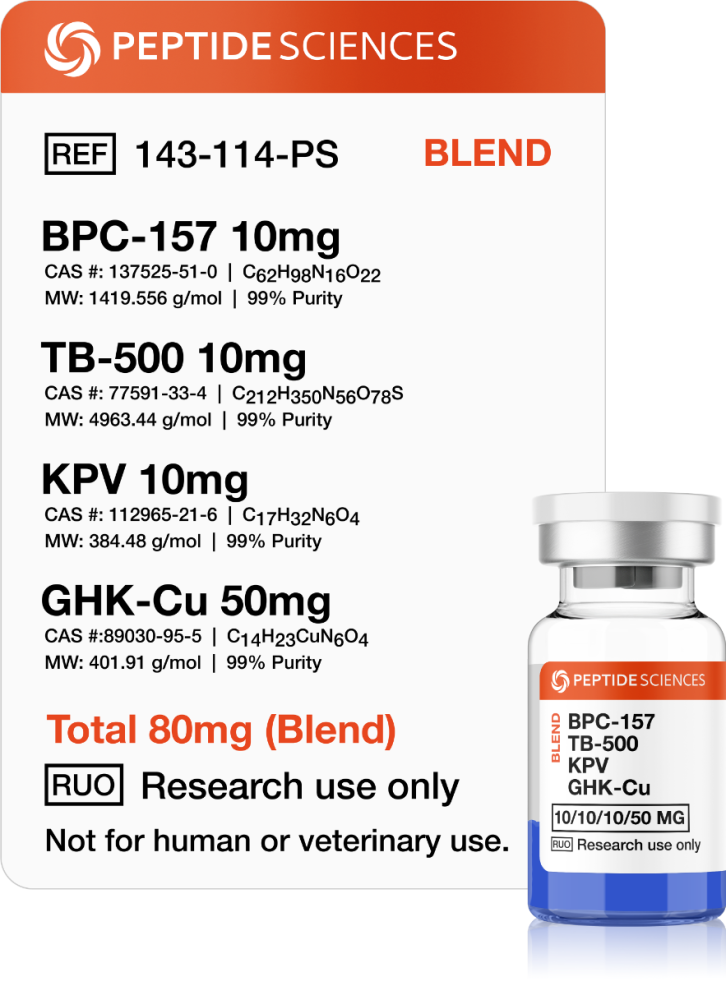
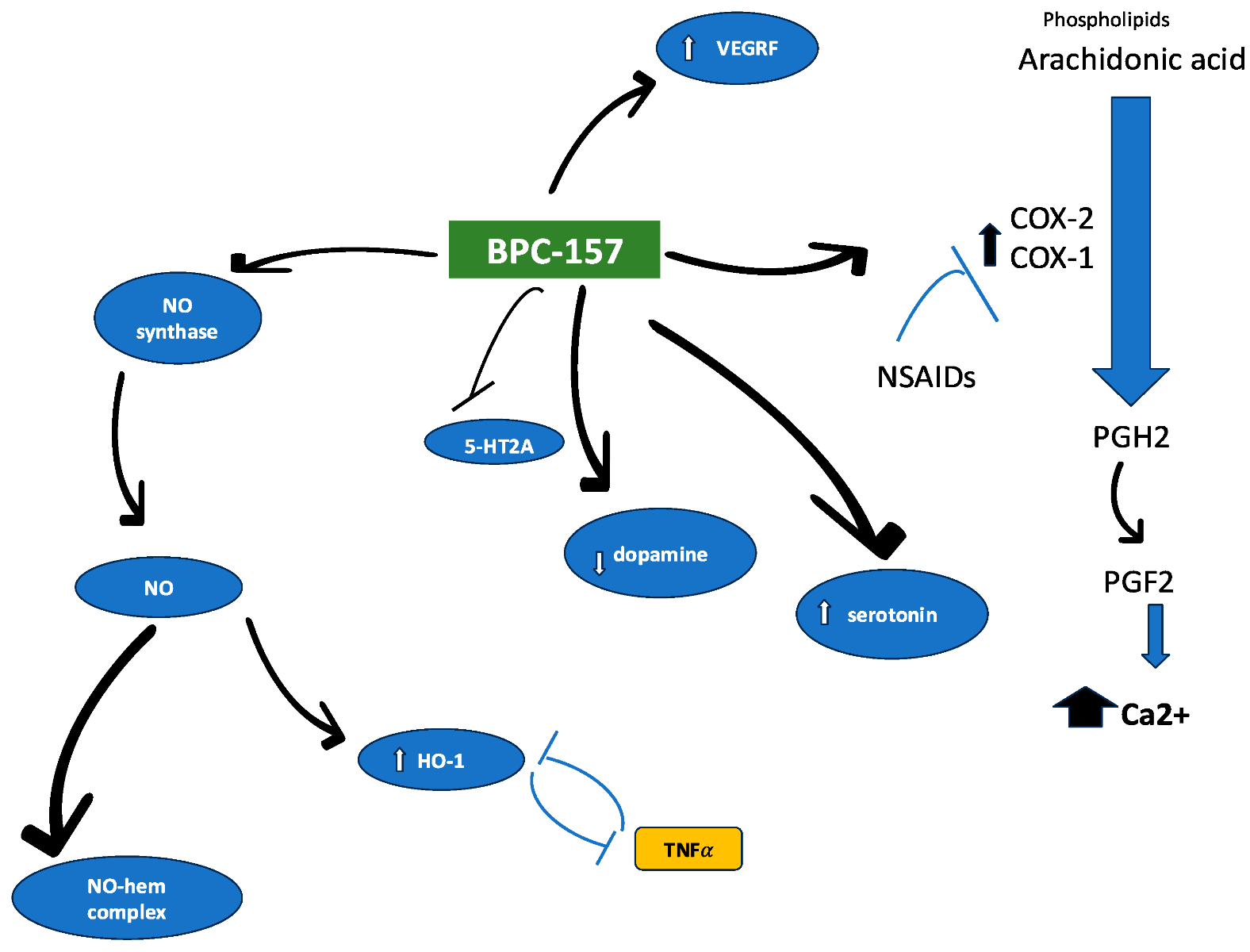
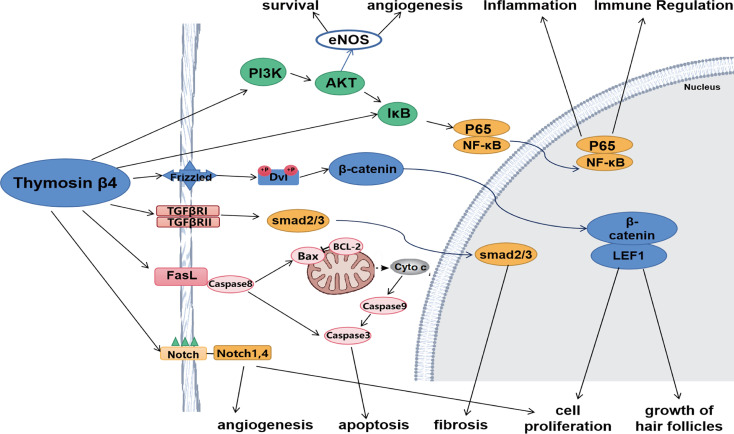
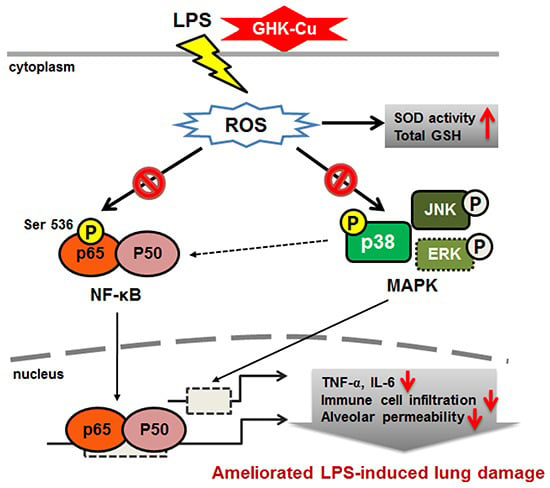
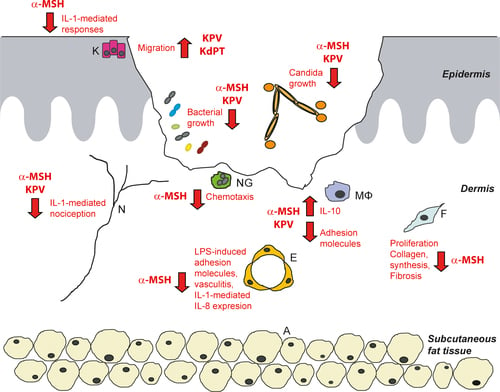
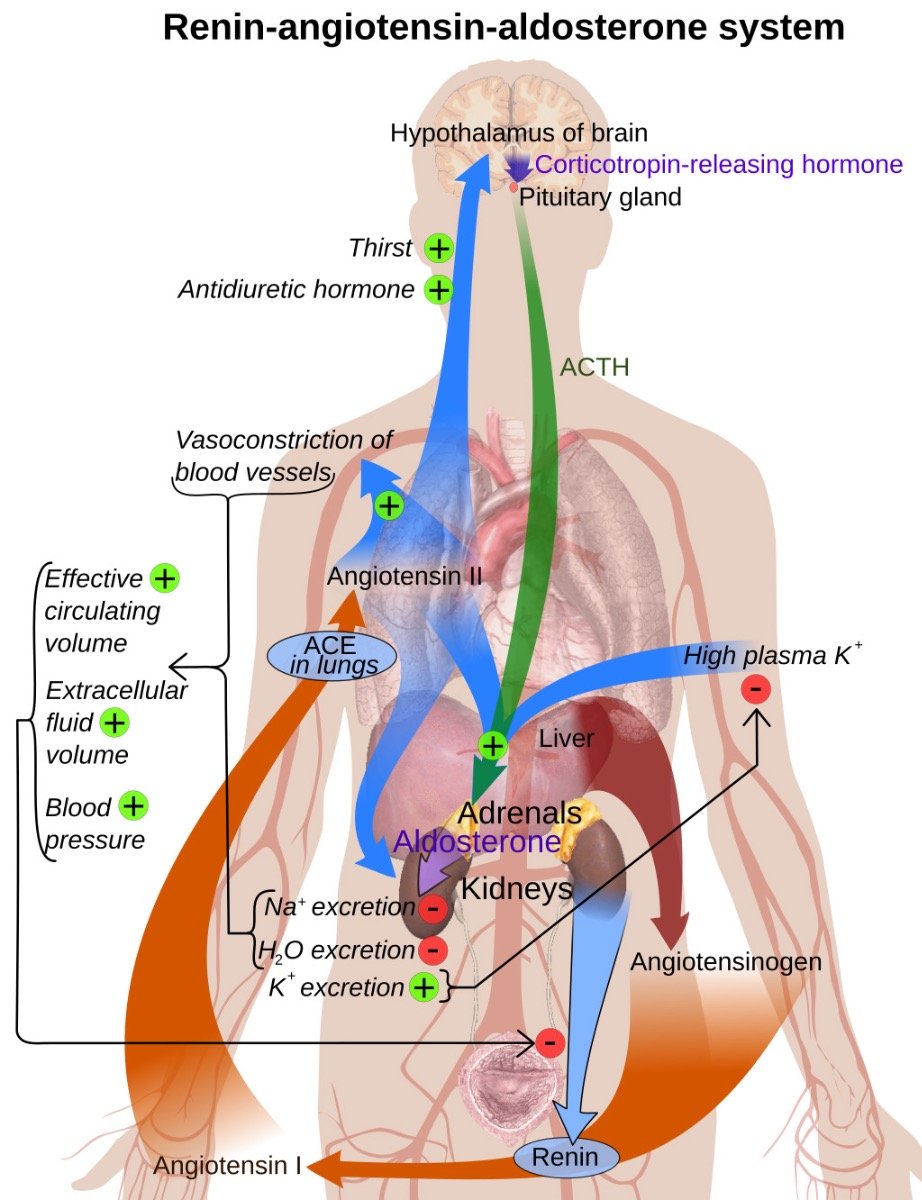
Reviews
There are no reviews yet.